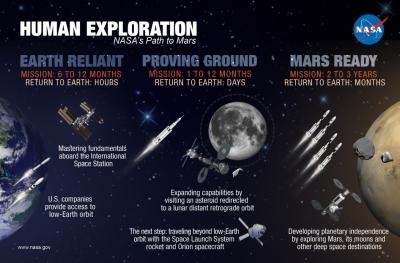Fri, Apr 25, 2014
Infographic From The Agency Shows Step-By-Step Plan
NASA is developing the capabilities needed to send humans to an asteroid by 2025 and Mars in the 2030s – goals outlined in the bipartisan NASA Authorization Act of 2010 and in the U.S. National Space Policy, also issued in 2010.

Mars is a rich destination for scientific discovery and robotic and human exploration as we expand our presence into the solar system. Its formation and evolution are comparable to Earth, helping us learn more about our own planet’s history and future. Mars had conditions suitable for life in its past. Future exploration could uncover evidence of life, answering one of the fundamental mysteries of the cosmos: Does life exist beyond Earth?
While robotic explorers have studied Mars for more than 40 years, NASA’s path for the human exploration of Mars begins in low-Earth orbit aboard the International Space Station. Astronauts on the orbiting laboratory are helping us prove many of the technologies and communications systems needed for human missions to deep space, including Mars. The space station also advances our understanding of how the body changes in space and how to protect astronaut health.
Our next step is deep space, where NASA will send a robotic mission to capture and redirect an asteroid to orbit the moon. Astronauts aboard the Orion spacecraft will explore the asteroid in the 2020s, returning to Earth with samples. This experience in human spaceflight beyond low-Earth orbit will help NASA test new systems and capabilities, such as Solar Electric Propulsion, which we’ll need to send cargo as part of human missions to Mars. Beginning in FY 2018, NASA’s powerful Space Launch System rocket will enable these “proving ground” missions to test new capabilities. Human missions to Mars will rely on Orion and an evolved version of SLS that will be the most powerful launch vehicle ever flown.
A fleet of robotic spacecraft and rovers already are on and around Mars, dramatically increasing our knowledge about the Red Planet and paving the way for future human explorers. The Mars Science Laboratory Curiosity rover measured radiation on the way to Mars and is sending back radiation data from the surface. This data will help us plan how to protect the astronauts who will explore Mars. Future missions like the Mars 2020 rover, seeking signs of past life, also will demonstrate new technologies that could help astronauts survive on Mars.
Engineers and scientists around the country are working hard to develop the technologies astronauts will use to one day live and work on Mars, and safely return home from the next giant leap for humanity. NASA also is a leader in a Global Exploration Roadmap, working with international partners and the U.S. commercial space industry on a coordinated expansion of human presence into the solar system, with human missions to the surface of Mars as the driving goal.
(Image provided by NASA)
More News
According To The Witness, Once The Airplane Landed, It Continued To Roll In A Relatively Straight Line Until It Impacted A Tree In His Front Yard On November 4, 2025, about 12:45 e>[...]
"In the frame-by-frame photos from the surveillance video, the left engine can be seen rotating upward from the wing, and as it detaches from the wing, a fire ignites that engulfs >[...]
Radar Required A term displayed on charts and approach plates and included in FDC NOTAMs to alert pilots that segments of either an instrument approach procedure or a route are not>[...]
From 2023 (YouTube Edition): It’s a Small World After All… Founded in 2011 by pilot, aircraft designer and builder, and U.S. Air Force veteran Sam Watrous, Uncasville,>[...]
Also: UFC Buys Tecnams, Emirates B777-9 Buy, Allegiant Pickets, F-22 And MQ-20 The NTSB's preliminary report on the UPS Flight 2976 crash has focused on the left engine pylon's sep>[...]
 NTSB Prelim: Funk B85C
NTSB Prelim: Funk B85C Aero-News: Quote of the Day (11.21.25)
Aero-News: Quote of the Day (11.21.25) ANN's Daily Aero-Term (11.21.25): Radar Required
ANN's Daily Aero-Term (11.21.25): Radar Required Classic Aero-TV: ScaleBirds Seeks P-36 Replica Beta Builders
Classic Aero-TV: ScaleBirds Seeks P-36 Replica Beta Builders Airborne 11.21.25: NTSB on UPS Accident, Shutdown Protections, Enstrom Update
Airborne 11.21.25: NTSB on UPS Accident, Shutdown Protections, Enstrom Update



